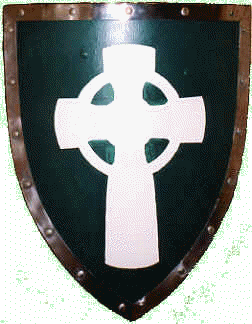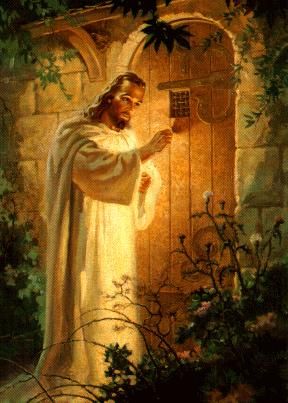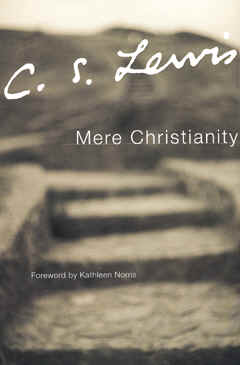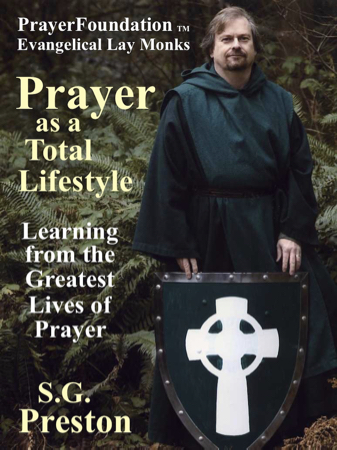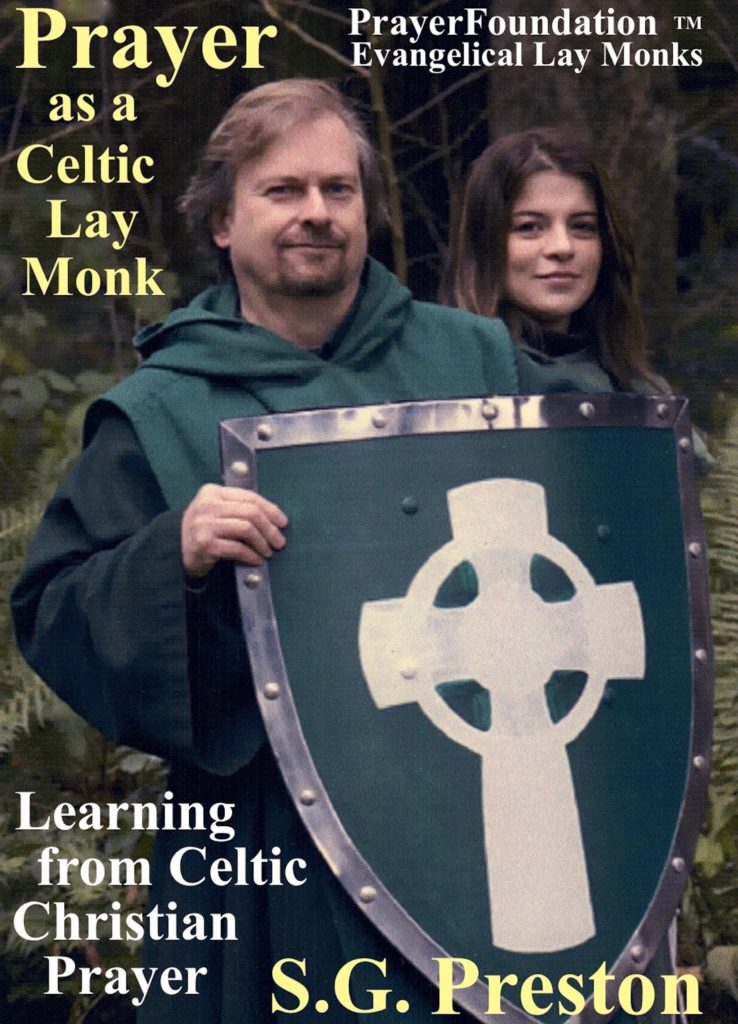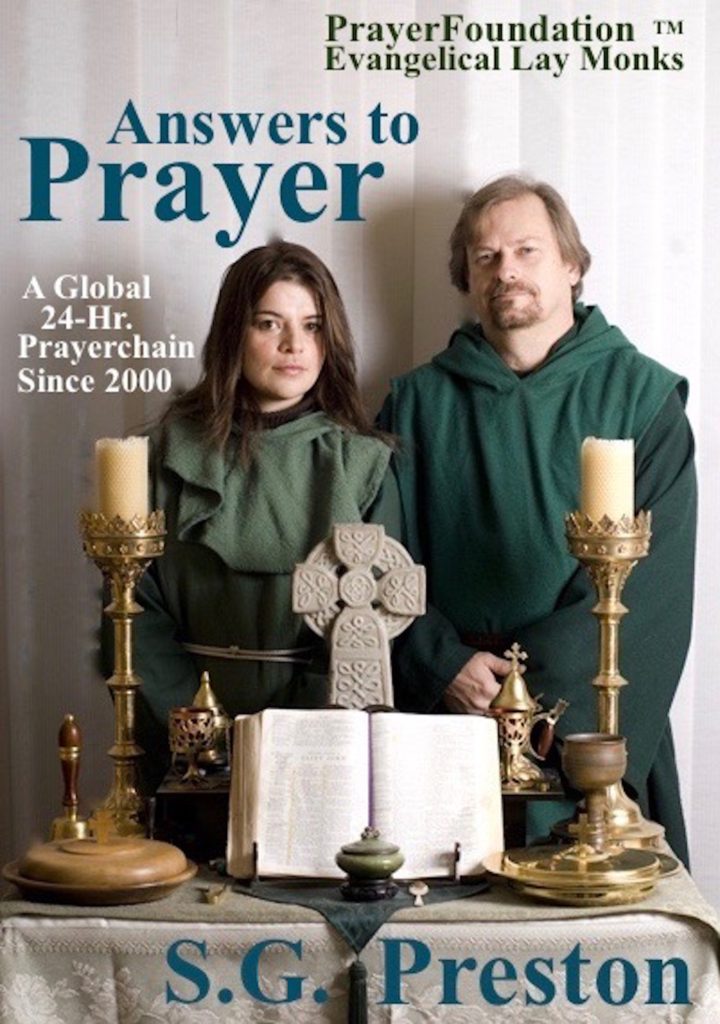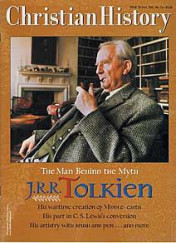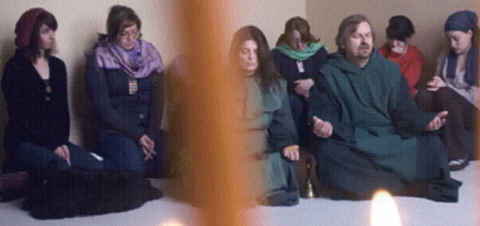
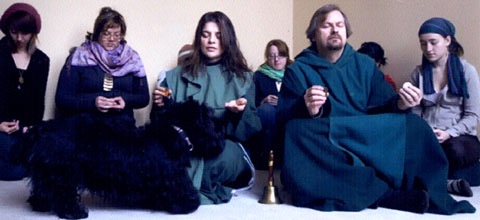
(Back Row): Faith, Tierney, Rex (behind candle), Jamie, Tracy, Lori. (Front Row): Scottie Monk-Dog Hermiston II, Lay Monk Linda, Lay Monk Preston. (Photos Copyright 2008 Leah Nash)
“But it is good for me to draw near to God. I have put my trust in the LORD God, so that I may declare all Your works.”
-Psalm 73:28
Once a month, the 2008 YWAM (Youth With A Mission) had a day of prayer; on this particular month, they decided to have it at our house monastery. We shared lunch, our Noon Daily Prayer: Praying the Hours, and our Worship Service with Communion.
Their Base Leader, Tierney, asked Lay Monk Preston to teach a class on prayer, which he was very happy to do. (Photos Copyright 2008 Leah Nash) Photo Shoot by World-Class Photographer Leah Nash.
The Unexpected Monks...
By Molly Worthen
Boston Globe / Ideas Section
February 3, 2008
Some evangelicals turn to monasticism, suggesting unease with megachurch religion –
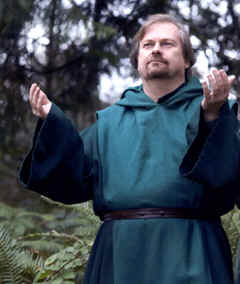
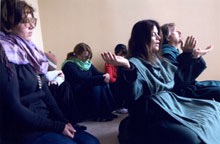

Our Monastery House is usually very quiet, but was slightly less so today.
Halfway through the day, Leah Nash, one of the top free-lance Photo-Journalists in the world, arrived to take photos for an article on New Monasticism scheduled to run in the Boston Globe newspaper.
Every year, at least one television station will film an interview with Lay Monk Preston, and it seemed very similar to that.
He had already answered questions for the article during a three-hour phone interview with Religion Historian and Professor, Molly Worthen, only a few weeks earlier.
Lay Monk Linda expressed it best for all of us, when she said that it was a real blessing to have such a group of young people around, who were so into following Christ, and being in His service.
_________________________________________
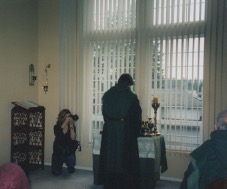
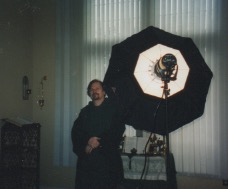
Boston Globe Article:“The Unexpected Monks…”
Evangelical Monks?
S.G. PRESTON IS a Knight of Prayer. Each morning at his Vancouver, Wash., home, he wakes up and prays one of the 50-odd psalms he has committed to memory, sometimes donning a Kelly green monk’s habit.
In Durham, N.C., Jonathan Wilson-Hartgrove and fellow members of Rutba House gather for common meals as well as morning and evening prayer based on the Benedictine divine office.
Zach Roberts, founder of the Dogwood Abbey in Winston-Salem, meets regularly with a Trappist monk to talk about how to contemplate God.
…monastic traditions loom large in their daily routines – yet all three men are evangelical Protestants.
The Protestant Reformers Rejection of Monasticism
The image of the Catholic monk – devoted to a cloistered life of fasting and prayer, his tonsured scalp hidden by a woolen cowl – has long provoked the disdain of Protestants.
Their theological forefathers denounced the monastic life: True Christians, the 16th-century Reformers said, lived wholly in the world, spent their time reading the Bible rather than chanting in Latin, and accepted that God saved them by his grace alone, not as reward for prayers, fasting, or good works.
Martin Luther called monks and wandering friars “lice placed by the devil on God Almighty’s fur coat.”
Of all Protestants, American Evangelicals in particular – activist, family-oriented, and far more concerned with evangelism than solitary study or meditative prayer – have historically viewed monks as an alien species, and a vaguely demonic one at that.
Yet some evangelicals are starting to wonder if Luther’s judgment was too hasty.
There is now a growing movement to revive evangelicalism by reclaiming parts of…tradition — including monasticism.
An Evangelical Monasticism
Some 100 groups that describe themselves as both evangelical and monastic have sprung up in North America, according to Rutba House’s Wilson-Hartgrove.
Many have appeared within the past five years.
Increasing numbers of evangelical congregations have struck up friendships with Catholic monasteries, sending church members to join the monks for spiritual retreats.
St. John’s Abbey, a Benedictine monastery in Minnesota, now makes a point of including interested evangelicals in its summer Monastic Institute.
“I grew up in a tradition that believes Catholics are pagans,” said Roberts, who was raised Southern Baptist and serves as a pastor in a Baptist church.
“I never really understood that. Now I’d argue against that wholeheartedly.”
In an era in which televangelists and megachurches dominate the face of American evangelicalism, offering a version of Christianity inflected by populist aesthetics and the gospel of prosperity, the rise of the New Monastics suggests that mainstream worship is leaving some people cold.
Transforming Evangelicalism
Already, they are transforming evangelical religious life in surprising ways.
They are post-Protestants, breaking old liturgical and theological taboos by borrowing liberally from Catholic traditions of monastic prayer, looking to St. Francis…for their social values, and stocking their bookshelves with the writings of medieval mystics rather than the latest from televangelist Joel Osteen.
On Fire for God
Monastics come from a variety of religious backgrounds, from Presbyterian to Pentecostal.
All share a common frustration with what they see as the overcommercialized and socially apathetic culture of mainstream evangelicalism.
They perceive a “spiritual flabbiness in the broader church and a tendency to assimilate into a corrupt, power-hungry world,” writes New Monastic author Scott Bessenecker in his recent book “The New Friars.”
Seeking a Deeper Spirituality
“New Monasticism is part of a broader movement stirring at the margins of American evangelicalism:
Evangelicals disillusioned with a church they view as captive to consumerism, sectarian theological debates, and social conservatism.
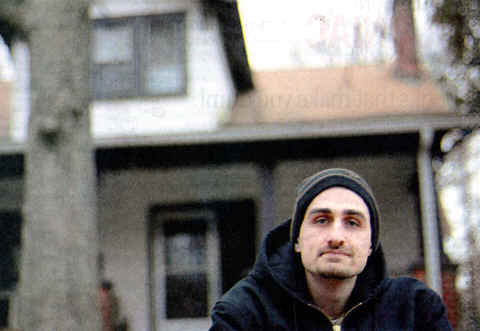
(Continued from Column at Left)
In their countercultural orientation, the New Monastics are true to the oldest monastic precedent. The founding father of monasticism, fourth-century Egyptian St. Anthony, gave away his worldly possessions and fled the temptations of the Roman Empire for desert solitude.
Old Monasticism / New Monasticism
Monasticism’s subsequent history is a complicated story of both extreme asceticism and descent into decadence, of the Vatican’s alternate promotion and suppression of charismatic holy men and women who criticized and compromised with the church hierarchy.
Though by the 16th century there was much truth in the Reformers’ charges of monastic depravity and corruption, the religious orders made up a diverse culture still home to rebels and critics: Martin Luther himself was an Augustinian friar.
Though New Monasticism is not entirely a product of the evangelical left – the Knights of Prayer, for example, are not interested in liberalizing movements within the church – most are trying to create an alternative to conservative mainstream evangelicalism.
Lay Monks: Living in “The World”
They embrace ecumenism over doctrinal debate, encourage female leadership, and care far more about social justice and the environment than about the culture wars.
Shane Claiborne, founder of one of the best-known New Monastic communities, the Simple Way of Philadelphia, asks that churches that invite him to speak offset the carbon emissions produced by his visit by “fasting” from fuel.
More fundamentally, New Monastics consider themselves “monks in the world.” They are not interested in extreme isolation or asceticism (though there are stories about the occasional Protestant “hermit” living in the Mountain West). Nearly all have regular jobs and social lives.
Lay Monks: Married Monastics
From the traditionalist perspective, many break the most essential monastic rule: they are married. Most groups support those who choose a celibate lifestyle, and a few have a member or two who do so, but it happens rarely.
Five centuries of Protestant heritage have alienated most New Monastics from the notion of religiously motivated celibacy.
More importantly, these groups do not aim to separate themselves from society – on the contrary, they see New Monasticism as a means to better integrate core Christian values into their lives as average citizens. This is the fundamental difference between old monks and the new.
Dietrich Bonhoeffer: “A New Kind of Monasticism”
New Monastics often quote one of their heroes, Lutheran theologian Dietrich Bonhoeffer, who captured the ambitions – and the ecumenical limits – of the movement when he wrote in 1935:
“the restoration of the church will surely come only from a new kind of monasticism which will have nothing in common with the old but a life of uncompromising adherence to the Sermon on the Mount in imitation of Christ.”
Concern for the Poor
Missio Dei is one of many groups that have deliberately made their homes in struggling urban neighborhoods. In addition to their routine of prayer and worship, they serve vegan meals to people on the street and offer hospitality to those who need it.
Van Steenwyk sees hypocrisy in churches that preach social justice from the pulpit, but ignore their struggling neighbors for the rest of the week.
“You can be involved with your church, but never really experience brokenness in another human being.
Jesus lived with other people,” he said. “So we ask, what are the resources throughout church history that can equip us to live life that way?”
Evangelical Contemplative Prayer
Serving the poor is not a new impulse among evangelicals, but serious contemplation is.
American culture has never placed a high priority on solitude, and historically, self-denial has gone hand in hand with bustling capitalist productivity, not contemplation (though the Puritans did balance their active lives with a heavy dose of journaling and soul-searching).
Opposition Views
Not all of their co-religionists, however, are pleased with these new spiritual ventures.
Van Steenwyk received e-mails from friends concerned about his “fringe activities,” including accusations that he’d “gotten into bed with the apostate Catholic Church.”
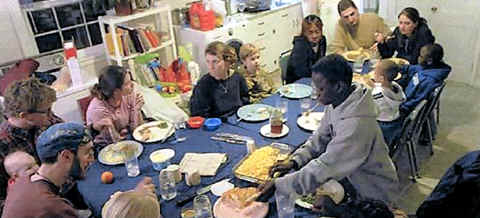
…these Christians represent only a small proportion of the approximate 60 million evangelical Americans. Yet their criticisms may resonate with more mainstream believers.
A recent study by Willow Creek Community Church in Illinois – one of the most influential megachurches in the nation – discovered that many churchgoers felt stalled in their faith, alienated by slick, program-driven pastors who focus more on niche marketing than cultivating contemplation.
The study suggested that megachurch members know how to belt out jazzy pop hymns from their stadium seats, but they don’t always know how to talk to God alone.
Monastic Prayer Practices
Many New Monastics live and worship together, and their practices sometimes resemble the communes and house churches associated with the Jesus Movement of the 1970s.
Like the hippies who were “high on Jesus,” New Monastics tend to favor simple living, left-leaning politics, and social activism.
However, they are quick to cite the intellectual seriousness and monastic forms of prayer and study that set them apart.
“I doubt most of the Jesus Movement people were reading the philosophers of their day in the way I have friends reading Zizek and Derrida,” said Mark Van Steenwyk, founder of Missio Dei, a New Monastic community in Minneapolis.
Van Steenwyk’s group has also compiled its own breviary, a book of scriptural texts that guides the group’s abbreviated version of the divine office sung in monasteries.
The Prayer Revolution
“The real radicals aren’t quoting Che Guevara or listening to Rage Against the Machine on their iPods,” writes Wilson-Hartgrove in a forthcoming book, “New Monasticism: What It Has to Say to Today’s Church.”
“The true revolutionaries are learning to pray.”
America has produced a few geniuses of contemplative life – Henry Thoreau and Emily Dickinson come to mind – but we have no indigenous contemplative tradition comparable to that of Catholic Europe or Buddhist Japan.
Yet contemplation is the heart of what it means to be a monk: the root of the word, monos, means “alone” in Greek.
Learning from the Taize and Iona Communities
Evangelicals have been tentatively exploring that side of Christian tradition since at least the 1978 publication of “Celebration of Discipline” by Richard Foster, a Quaker theologian who recast fasting and meditative prayer for an evangelical audience.
His book sold nearly 2.5 million copies and launched a cottage industry of evangelical contemplative literature – a phrase that, 30 years ago, was a contradiction in terms.
Some evangelicals made pilgrimages to the handful of older ecumenical monastic communities abroad, such as the Taizé Community (founded in Burgundy, France, in 1940), and the Iona Community, founded in 1938 at St. Columba’s landing place in the Inner Hebrides.
They brought back what they learned, and have tried to make it their own.
(Continued in Column at Right)
Painting: “Heart’s Door” by Warner Sallman. © Warner Press, Inc. Anderson, Indiana. Used by permission.
Catholic Views
Though many Roman Catholics have mixed feelings about evangelicals who adopt a hodgepodge of watered-down monastic practices and call themselves “monks,” some are supportive of New Monasticism.
They view the movement as part of a wider rapprochement between Protestant evangelicals and Rome.
A half-century of theological shifts on both sides of the divide – Vatican II’s liberalizing impact on the Catholic Church, and the waning of Protestant fundamentalism – as well as the decline of traditional ethnic resentments and an emerging pattern of political cooperation have all prepared the way.
Father Jay Scott Newman, a priest in South Carolina, said that the New Monastic movement suggests a profound shift in evangelical identity.
“Until very recently, an evangelical of whatever stripe included in his self-definition not just opposition to, but violent rejection of everything Catholic,” he said.
“That’s no longer true. That’s dramatic, revolutionary, and I think, lasting.”
A New Evangelical Lay Monasticism
To some Catholic observers, it is no shock that evangelicals have begun to feel the lack of organized contemplative life and yearn for a bond with religious tradition – they’re only surprised that it took them so long.
“Monasticism has been such a powerful thing in the West and the East for so long that it would be very peculiar if it didn’t, at one point or another, erupt in evangelical circles,” said William Shea, director of the Center for Religion, Ethics, and Culture at the College of the Holy Cross.
“It’s just too long, too deep, too creative a tradition. You could call this movement ersatz monasticism, but I would hold back and ask, where might this lead?”
Molly Worthen, a New Haven-based writer, is working on a book about evangelical intellectual life.![]()
© Copyright 2008 Globe Newspaper Company.
______________________________________________________
Credits:
The text of the Boston Globe Articles: “The Unexpected Monks…” and “In the Beginning…” are re-printed by permission of the author, Molly Worthen.
Photos of our Monastery Chapel, and of S.G. Preston and his wife, Linda, are re-printed by permission of the Photographer: Leah Nash. (Photos Copyright 2008 Leah Nash)
________________________________________________________________________
wORlD EvAnGElisT billy gRaham:
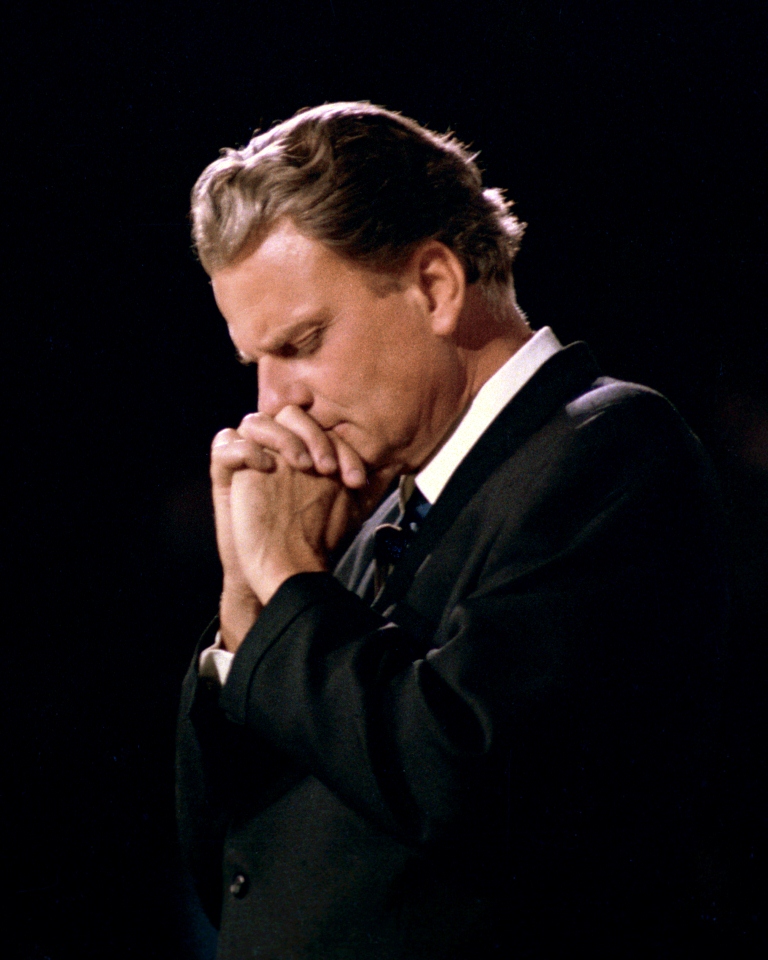
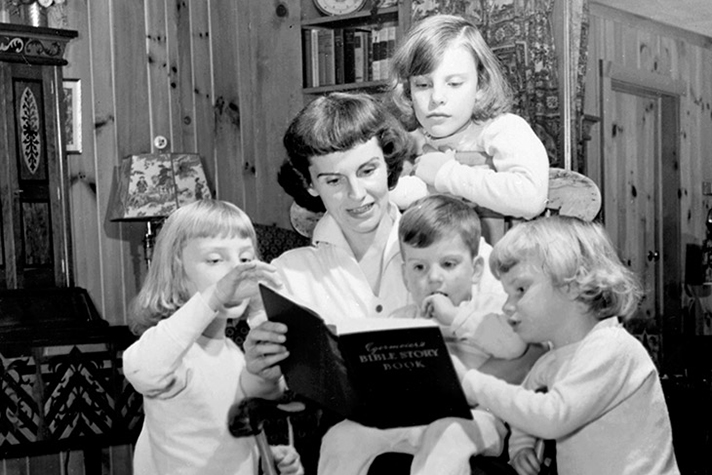
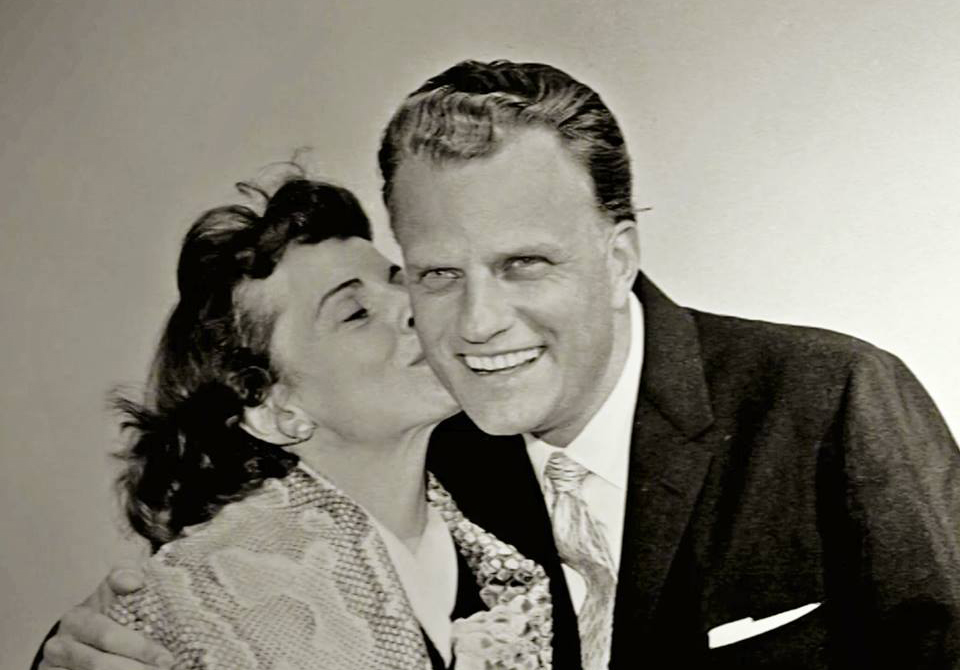
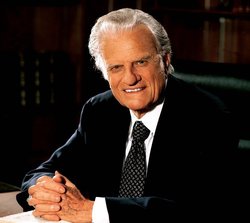

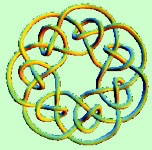
“Every day has exactly 1,440 minutes;
can’t you find even 10 of them to be with your heavenly Father?
Doesn’t God deserve the best minutes of your day?”
“Satan will contest every hour you spend in
Bible reading and in prayer.”
____________________________
-Rev. Billy Graham (1918-2018)


This Website: PrayerFoundation Evangelical Lay Monks ™ Built by: S.G. Preston Ministries ™
Copyright © 1999-2024 S.G. Preston. All Rights Reserved.
Photos & Text Copyright © 1999-2024 S.G. Preston. All Rights Reserved.
